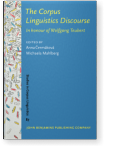Michael Stubbs
List of John Benjamins publications for which Michael Stubbs plays a role.
2019 Chapter 8. Fact, fiction and French flights of fancy Style, Rhetoric and Creativity in Language: In memory of Walter (Bill) Nash (1926-2015), Simpson, Paul (ed.), pp. 127–148 | Chapter
This chapter discusses a satirical novel: La septième
fonction du langage by Laurent Binet, published in 2015. The
book is a thriller with a deliberately absurd plot about a search for a lost manuscript which holds the secret of ultimate rhetorical power: the ability to convince anyone… read more
2018 The (very) long history of corpora, concordances, collocations and all that The Corpus Linguistics Discourse: In honour of Wolfgang Teubert, Čermáková, Anna and Michaela Mahlberg (eds.), pp. 9–34 | Chapter
In the development of academic disciplines, important ideas are often proposed, forgotten, and then rediscovered much later, when they are connected to other ideas in a way which reveals their significance. I give examples of ideas which are often thought of as quite modern, although they have a… read more
2015 Chapter 4. The textual functions of lexis Corpora, Grammar and Discourse: In honour of Susan Hunston, Groom, Nicholas, Maggie Charles and Suganthi John (eds.), pp. 97–116 | Article
This chapter reviews studies which show how lexis contributes to textual organisation. It concludes that there are many interesting case studies, but that some hypotheses could be formulated more explicitly, and that findings could be better integrated into a functional theory of lexis. As a short… read more
2014 Searle and Sinclair on communicative acts: A sketch of a research problem The Functional Perspective on Language and Discourse: Applications and implications, Gómez González, María de los Ángeles, Francisco José Ruiz de Mendoza Ibáñez, Francisco Gonzálvez-García and Angela Downing (eds.), pp. 243–260 | Article
John Searle and John Sinclair have worked in very different academic traditions:
analytic philosophy and empirical linguistics. Nevertheless, although they
work with very different methodological and theoretical assumptions, they both
tackle one of the deepest questions in the philosophy of… read more
2013 Sequence and order: The neo-Firthian tradition of corpus semantics Corpus Perspectives on Patterns of Lexis, Hasselgård, Hilde, Jarle Ebeling and Signe Oksefjell Ebeling (eds.), pp. 13–34 | Article
Corpus linguists often attempt to avoid assumptions imported from pre-corpus studies, by using methods which could be called “inductive”, in so far as they proceed from observations about textual sequences to generalizations about order in the system. However, induction has been questioned for over… read more
2010 Three concepts of keywords Keyness in Texts, Bondi, Marina and Mike Scott (eds.), pp. 21–42 | Article
The term “keywords” is widely used to refer to words which are important in some way, either in individual texts or in a given culture. The general idea is perhaps clear enough, but there are two problems. First, there are several different concepts of “keywords”. This paper discusses three loosely… read more
2009 Technology and phraseology: With notes on the history of corpus linguistics Exploring the Lexis–Grammar Interface, Römer-Barron, Ute and Rainer Schulze (eds.), pp. 15–32 | Article
From the 1700s onwards, important linguistic concepts and methods were developed and forgotten, then re-invented, sometimes much later, when the intellectual climate had changed and/or when technology had advanced. Examples include work on concordances (1700s: Cruden, Ayscough), on collocations (ca… read more
2009 Review of Sebba (2007): Spelling and society: The culture and politics of orthography around the world Evidentiality in language and cognition, Ekberg, Lena and Carita Paradis (eds.), pp. 161–164 | Review
2002 Two quantitative methods of studying phraseology in English International Journal of Corpus Linguistics 7:2, pp. 215–244 | Article
Word frequency lists are a standard resource for many theoretical, descriptive and applied questions. However, due to severe problems of definition, there are no equivalent lists which give the frequency of phrases. This paper proposes two independent methods of studying the frequent phraseology… read more
1997 Review of McEnery & Wilson (1996): Corpus Linguistics International Journal of Corpus Linguistics 2:2, pp. 296–302 | Review
1995 Collocations and semantic profiles: On the cause of the trouble with quantitative studies Functions of Language 2:1, pp. 23–55 | Article
Current work on lexical collocations uses two ideas: (i) words have distinctive semantic profiles or "prosodies"; and (ii) the strength of association between words can be measured in quantitative terms. These ideas can be combined to provide comparative semantic profiles of words, which show the… read more
1994 Review of Scholes (1993): Literacy and Language Analysis Functions of Language 1:2, pp. 307–310 | Review
1993 British Traditions in Text Analysis — From Firth to Sinclair Text and Technology: In honour of John Sinclair, Baker, Mona, Gill Francis and Elena Tognini-Bonelli (eds.), pp. 1–36 | Article
1992 Institutional linguistics: Language and institutions, linguistics and sociology Thirty Years of Linguistic Evolution: Studies in honour of René Dirven on the occasion of his 60th birthday, Pütz, Martin (ed.), pp. 189–214 | Article

















